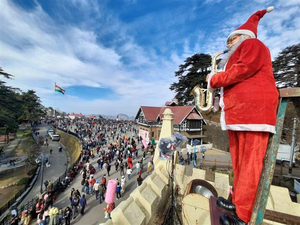Shimla: Shimla’s climatic conditions have changed many times and old-timers blame it on the abnormal rise in human activities that have released large amounts of carbon dioxide and other greenhouse gases into the atmosphere.
The capital of Himachal Pradesh, which is known for the grandeur of many of its buildings that once housed institutions of imperial power when Shimla served as the summer capital of British India, has been witnessing snowless Christmas Eve since 2016 when heavy snowfall occurred.
This time too, there will be no “white” Christmas in Shimla and elsewhere in the state. A mellow sunshine will greet you throughout the day at most of the tourist destinations with the weather bureau predicting open skies till December 26.
Before 2016, the erstwhile capital of British India saw Christmas snows in 1991 when 49 cm of snowfall was recorded. Though some years between 2014 and 2018 had mild spells before the Yuletide spirit.
Also except in 2010, there has been no white New Year’s Eve either in the past 12 years.
Deforestation and pollution are blamed for the change in Shimla’s climatic conditions, says a study by the India Meteorological Department (IMD).
It says Shimla’s harsh winter, which normally commenced in November and ended in March, has declined after the mid-1980s. The study examines the snowfall trend in Shimla from 1990 to 2007.
The local IMD says the entire state will witness bright sunshine on December 24 and 25. In the past week, the temperatures of Shimla were much higher than that of New Delhi.
Snow cover is a big draw for tourists, and members of the hospitality industry are excited by the possibility of a white Christmas as the festival falls right after the weekend.
“People are asking about the possibility of snowfall before and after Christmas,” local hotelier D.P. Bhatia told IANS.
“We are telling them to come and enjoy balmy sunshine amidst the hills,” he added.
The mountain peaks viewed from Shimla’s historic Ridge and Dharamsala and Palampur towns have been wrapped in a blanket of snow.
According to the IMD, the weather in hill destinations of Shimla, Kasauli, Chail, Kufri, Narkanda, Dharamsala, Palampur and Manali is ‘warmer’ and perfect for a break from the biting chill of the plains where the sun has largely been fogged out.
Met officials, however, are wary about the chances of snowfall on New Year’s Eve. They say it is still too early to predict whether Shimla or Manali or Dalhousie or Kalpa will have snow cover the next year dawns.
However, excited holidaymakers, mainly from the northern plains, have already started descending on tourist resorts across the state with the hope of a “white” Christmas.
Many of them have booked rooms in the hope of a white Christmas.
Dinesh Guleria, a senior executive with a Chandigarh-based multinational company, said: “If it snows, we would love to spend the Christm+as holidays in a homestay in Narkanda. Otherwise, we will enjoy sunny weather in Shimla.”
“Most of our properties have been packed to capacity with Christmas holiday-makers,” a senior official with the Himachal Pradesh Tourism Development Corporation (HPTDC) told IANS.
The HPTDC runs 57 economy and high-end hotels across the state. He said the arrival of the tourists in Shimla, Narkanda, Kasauli, Manali, Dalhousie and Dharamsala is quite good.
However, the popular tourist resort Narkanda, some 65 km from Shimla, is bereft of snow like Shimla and Manali.
But Manali is getting a good share of tourists as its nearby hills have plenty of snow.
According to Global Forest Watch, an online platform that provides data and tools for monitoring forests, from 2001 to 2022, Shimla lost 583 ha of tree cover, equivalent to a 0.27 per cent decrease in tree cover since 2000, and 292 kt of carbon dioxide emissions.
Under the guise of climate “scepticism”, most of the old-timers in Shimla narrate the tale of indiscriminate construction that has turned the summer retreat of the then-British rulers into a concrete jungle in the past few decades.
Some residents have been wondering if the rise in minimum temperatures in recent years in winter is a result of global warming, though scientists have said the overall warming trend should not have any effect on local weather on such short-time scales, as per current models.
–IANS


Comments are closed.